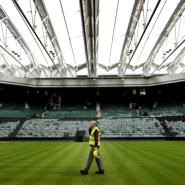THE RESOUNDING way in which Red Bull wrapped up the front row for today’s Chinese Grand Prix — despite a new technical ruling — finally brought an end to conspiracy theories that the team had previously been using a secret system of ride height control to enhance their cars’ aerodynamics.
Between the previous race in Malaysia and this one, the sport’s governing body, the FIA, issued a statement to the teams outlining that any devices or systems that altered the set-up of the cars between qualifying and race were illegal. Red Bull’s rivals believed the team had been using such a system before its ban and that the new ruling would clip their wings. Red Bull insisted they had no such device. Before the clarification McLaren had been developing a system of ride height control, which was due to have been fitted to the cars of Lewis Hamilton, inset, and Jenson Button for today’s race.
The Red Bull RB6 has set pole position for all four races of the season so far. Although it was affected by reliability issues in the opening two races, Sebastian Vettel and Mark Webber delivered the team an impressive 1-2 in Kuala Lumpur two weeks ago. Fears that the RB6 might dominate the season seem realistic, especially now that the new ruling seems to have left Red Bull’s advantage unaffected.
An F1 car’s aerodynamic performance is enhanced the lower to the ground the car can run. As the carefully sculpted underbody runs close to the ground, so it creates low-pressure areas that essentially suck the car down to the track’s surface, increasing its cornering and braking grip. Therefore, teams set the suspensions to run the car as low as possible. For this season cars are allowed to qualify with enough fuel on board just to complete the qualifying laps. Before the race the fuel load required to complete the distance — typically about 150kg — is then pumped into the tanks. This pushes the car closer to the ground and so allowance has to be made for this when setting the ride height for qualifying, as no changes are allowed to be made to the suspension set-up in between qualifying and race. A system that automatically compensated for fuel loads and kept the ride height at its minimum on low fuel loads and on high loads would give a performance advantage in qualifying estimated by engineers at about half a second per lap.
Red Bull’s team principal, Christian Horner, said of the China qualifying result: “I think this just confirms that we have a very quick car and that it’s nothing to do with any supposed trick ride height control. We have not got and have never had such a system.”
The rumours began when it was noted the car apparently scraped its floor along the ground during qualifying for the opening race in Bahrain. If it was doing that before 150kg of fuel was added, reasoned the rivals, there must be a compensating system. Red Bull insist the low ride height was caused by nothing more than under-pressured tyres.
The team have been cheekily delighting in the confusion sowed by the rumours. “I’m just glad we’ve been able to lose the others some nights’ sleep,” said Webber. “All that time chasing that means time they’ve lost chasing what they should have been.”
Vettel talked with a smile about a lever in his cockpit “that the team tell me to move up and down — I don’t know what it does, but it seems to work”.
FIA scrutineers have inspected the car and declared themselves completely satisfied with its legality. So the race is now on among rivals of the the Milton Keynes-based team to catch up.
Mark Hughes writes for Autosport magazine
Subscribe to:
Post Comments (Atom)











No comments:
Post a Comment